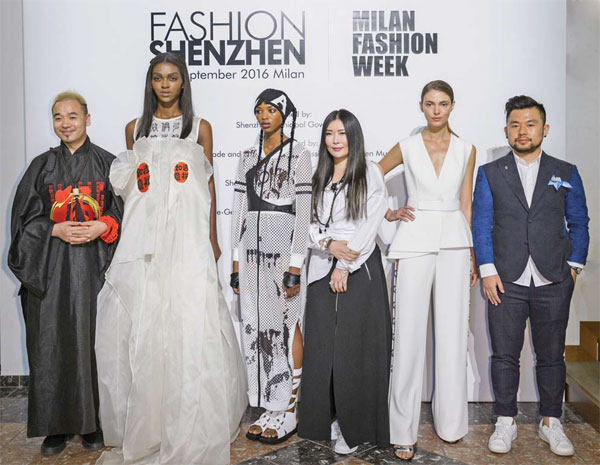Shenzhen now in fashion
Updated: 2016-10-14 07:36
By Mariella Radaelli(China Daily Europe)
|
|||||||||
Young, vibrant designers from the southern Chinese city make their debut at Milan Fashion Week
China's young but vibrant fashion industry was traditionally centered in Shanghai and Beijing, but now Shenzhen is strutting its stuff on international catwalks.
A raft of labels from the southern Chinese city made their Milan Fashion Week debuts this year, including pret-a-porter brand Ellassay, Xie Haiping and La Pargay.
|
Chinese designers at Milan Fashion week including Xie Haiping; Lai Rui, founder of La Pargay; and Wang Dusen, brand image management center director for the brand Ellassay. Imax Tree / For China Daily |
Work by 18 young Shenzhen designers was also showcased on Milan's catwalks, in an event organized by the nonprofit Shenzhen Garment Industry Association.
The show in late September comes after Shenzhen labels featured at the London and New York fashion weeks, and amid a growing international appetite for quality made-in-China goods.
Shenzhen's creativity will be part of the Milan event every year from now on, says Francesco Fiordelli, an Italian designer and ambassador for the Shenzhen garment industry in Europe. He says, "Milan means internationalization and visibility."
China's fashion textile sector has been "extremely lively" since the new government policies made the sector "absolutely strategic", he says.
"The industry (in Shenzhen) has developed over the past five years, at an increase of 37 percent," he says. "Specifically, sales of women's clothing brands in China have risen more than 26 percent, while footwear and accessories are up more than 41 percent."
Women's brands now have substantial market power, Fiordelli says, explaining that women's garments account for 85 percent of production in the city, which is also home to 85 percent of Chinese women's fashion companies.
"Shenzhen is the most important women's garment-producing district in China," as it has shaped an entire supply chain, stretching from fabric production to distribution, he says.
The city is home to 3,500 clothing brands and 15,000 designers, mostly in Dalang Fashion Valley. It is also known as the Chinese capital of interior design.
"Working on the internationalization of Shenzhen brands is my life's mission," says Shen Yongfang, president of the Shenzhen Garment Industry Association, which along with promoting brands works to protect trademarks and other intellectual property against cheap, unauthorized knockoffs.
Over the years, Shen has invited many European experts to the city to build collaborative relationships with local designers.
She is also the founder the China International Brand Clothing and Accessories Fair, now in its 16th year, which attracts 1,200 exhibitors and about 5 million visitors to Shenzhen. She also helped establish the Shenzhen Clothing R&D Center and the Shenzhen Clothing and Garment Industry Cluster in the early 2000s.
"The brands in the cluster, such as Marisfrolg and Yinger Group, have experienced rapid growth in the past decade. They have achieved billions of yuan in annual sales," Shen says.
Meanwhile, Shen says Chinese women can find true elegance without having to wear European brands.
"They are already behaving that way around the world," she says. "An elegant woman may wear a pair of superb Ferragamo shoes and a simple qipao (traditional Chinese dress) made with our unique silk. And that's it. Look at our first lady (Peng Liyuan); she is a model of elegance".
She is also confident about the future development of Dalang Fashion Valley.
"China's fashion industry is becoming more international thanks to connections and the regular exchanges of expertise, especially from Europe, the birthplace of fashion," Shen says. "China is not only a big garment country. Soon, we will become a powerful garment country. Ethnic and cultural elements are the source of fashion inspiration."
Qu Xin, the mayor of Shenzhen, says the city will continue to support the fashion industry and invest in the production chain. Part of this effort will be to train the next generation of designers and industry professionals, such as tailors, cutters and pattern makers, he says.
"We have become the most creative fashion hub in China," he says. "We'll achieve the impossible by establishing Shenzhen as an international center and a pole of attraction through the development of a fashion city, along with consolidation of fashion week and the fashion fair."
Italian fashion academy Istituto Marangoni has also opened a training center in the city.
Shenzhen, which neighbors Hong Kong, grew from a fishing village into a modern metropolis after former leader Deng Xiaoping launched his reform and opening-up policies.
"Deng was the 'ferryman' of economic development," Shen says. "He nourished an economic boom that radically improved the lives of citizens. Shenzhen today is a reflection of Deng's extraordinary vision."
For China Daily
( China Daily European Weekly 10/14/2016 page22)
Today's Top News
Xi: China considers Bangladesh important partner
Britain's May, faced with turmoil, agrees to a debate
Deals with Cambodia include energy, trade
Trump accused of inappropriate touching by women
China expresses condolences over death of Thai King
Chinese president arrives in Cambodia for state visit
Thai King, world's longest-reigning monarch, dies
Q3 trade growth rebounds, pressure remains
Hot Topics
Lunar probe , China growth forecasts, Emission rules get tougher, China seen through 'colored lens', International board,
Editor's Picks

|

|

|

|

|

|








